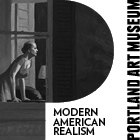Click here for Part 1
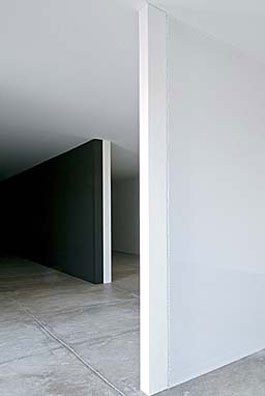
Robert Irwin, Installation at the Chinati Foundation, 2006-7
The scrims are freestanding in the spaces of the barracks. The frames are exposed so you are more aware of their edges. Some are painted white while others are black. Both challenge and redefine your perception of walking down the rooms. The works can't exist independently of the rooms in which they are placed.
So much about what we are taught about art is about the integrity of the original work because it allows a direct connection back to the artist. In that case it is the connection back to the artist that is important and valued, the work is seen as valued as proof of that condition whether the work still functions the way that artist intended to or not. Could the paintings Black Square paintings be painted by someone else and still have the same effect? I would still say no, if only for respect for the artist and their discovery. A Black Square painting by Malevich has integrity to the idea while a painting of the Black Square by someone else is just a copy of a painting by Malevich. Malevich's painting is an experience while the painting by someone else would be symbolic of that experience but not the experience itself. Art is an experience framed or postulated by an artist and so it is inevitable and necessary that the work is read according to their intentions. That is our source. A Black Square painting made by someone would be different, and impossible if the artist was no longer alive, unless that was the artist's intention.
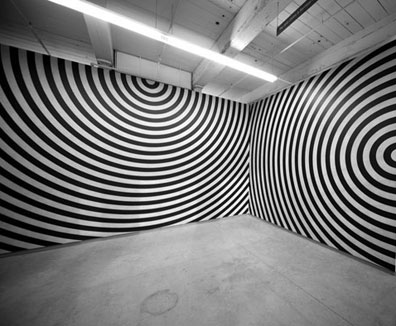
Sol Lewitt, Some of the wall drawings at MASS MoCA, 2008
Like everything else, Lewitt's wall drawings are drawn for the first somewhere. But for each successive installation, they are created anew. Some drawing relate to specific elements in the room and so then it is conceivable that the work might substantially change from one installation to the next. Others rely on the preferences (or height) of the people doing the drawing so those too would change from one installation to the other. Finally, some drawings are a fixed internal relationship and so would change very little from one installation to the next. Either the installation works and embodies the parameters of that particular drawing or it doesn't. There is no in between.
The other model would be a wall drawing by someone like Sol Lewitt. In the wall drawings, there might be a date for the first time that the work is drawn but it is made new every time it is installed. One example is not any better than earlier or later example, they are the same thing. In this case, the original object is de-valued and transient because the work exists in any situation in which those parameters established by the artist are present and questions of priority are, at best, secondary. A less obvious example would be James Turrell's Skyspaces. Is the art the box or the sky? For everyone else it might be the box but for Turrell it is clearly the sky. For Turrell, the box of the Sky Space is just a tool for getting us to focus on the sky. Everything is created to emphasize the transition of colors in the sky at dawn and sunset. There is no original and there is not a precedent, at least in terms of having the "original" day. Each day the piece remakes itself. Each day the relationships are uniquely reestablished. Is one sunset "better" than another one? I am not sure and even if it were I am not sure that it would matter because the sky can't be made to stay still. It seems clear to me that Malevich saw his work in terms closer to an artist like Lewitt and Turrell rather than other artists that might fetishize the original object. Art is transient and fragile, so the more opportunities there are to reestablish the connections that make the work the better but only with respect to the intention of the artist.
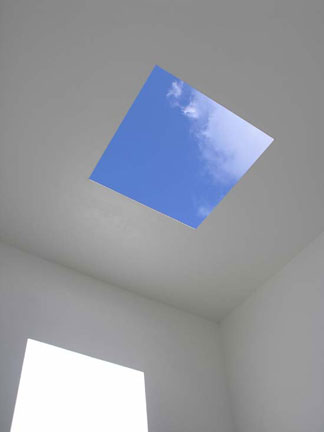
James Turrell, Skyspace, 2006
In Turrell's Skyspaces, he goes through a lot of work to get us stop and look at something that we see all the time. He is trying to get us to slow down and attempts to build an environment in which all of the distractions are removed, so that, potentially, we might see the sky in a new way. The irony is that the Skyspaces are very expensive, while the work, the sky itself, is free. Even better is that it changes every day and it is never the same twice. The Skyspace is completely necessary for the experience but it isn't the experience of the work, our communion with the sky is.
These are questions that allow for a potentially deeper understanding on the nature of art and the way that we choose to value it. The more we think about these issues, the greater the potential that we will discover other opportunities and other ways of experiencing art.
When you are looking at these works you will see extremely simple, geographic, or neutral forms again and again from very different types of artists. Why did artists that were so varied in terms aesthetic and approach, find similar solutions to the problems that they had set up for themselves? What problems did those shapes or forms solve for the artists? In almost every case, the very simple shape allowed the perspective shift from the work as an object to the work as a space. There is a sublter shift as well, because while the work is an object, you are always outside of it. When the work is a space, the experience of the work is identical to your experience of the space. You become the subject of the art. These works sometimes seem boring or bland because there does not seem to be anything there to see. Their is nothing to distract from the experience of direct awareness of the totality of the work. That is precisely their value and it is what makes them successful. These are all experiences that originate in Malevich's Black Square.
Art is about the way the experience is presented. The work acts as an interface between you and the artist's intention. It is why we looking is such a worthwhile and valuable experience because we keep learning about new ways to see the world. That's why Malevich's square is a different than yours and the way that Turrell sees the sky is different than the way we see sky when we look at outside. In case you are wondering about the significance or importance of ideas that like this, it is worth remembering that Malevich went to jail for advocating for Suprematism, or in other words the direct experience of art, at a time when any art that did not serve a political need was thought of as being worse than useless. These ideas were seen as a threat to the established order. Perhaps, they still are.
"The black square on the white field was the first form in which nonobjective feeling came to be expressed. The square = feeling, the white field = the void beyond this feeling. Yet the general public saw in the nonobjectivity of the representation the demise of art and failed to grasp the evident fact that feeling had here assumed external form. The Suprematist square and the forms proceeding out of it can be likened to the primitive marks (symbols) of aboriginal man which represented, in their combination, not ornament, but a feeling of rhythm. Suprematism did not bring into being a new world of feeling but, rather, an altogether new and direct form of representation of the world of feeling."
-Kasimir Malevich, The Non-Objective World
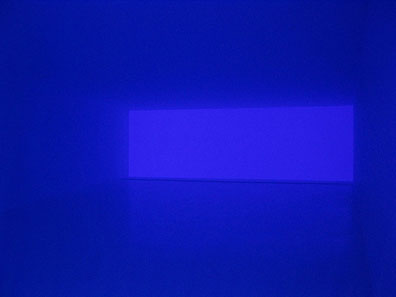
James Turrell, Ganzfeld: Tight End, 2005
When Turrell makes the opening for the Ganzfeld (Entire Field), he is trying to find the most neutral, undistracting way possible. In the Ganzfeld, the openings echo the geometry and shape of the room to be as simple as possible. He is trying to simplify everything so that we will be able to open ourselves to the experience of the light. In his spaces, we experience light in a new way. Somehow the room and the work have gone beyond being mutually defining, they are have become one and the same. The work does not have any boundaries except for those of the room. To enter the room is to enter the work. The room itself is empty except for our experience, our feeling, of the light in probably the most extreme applications of a series of ideas that Malevich starting work with nearly a century before.



